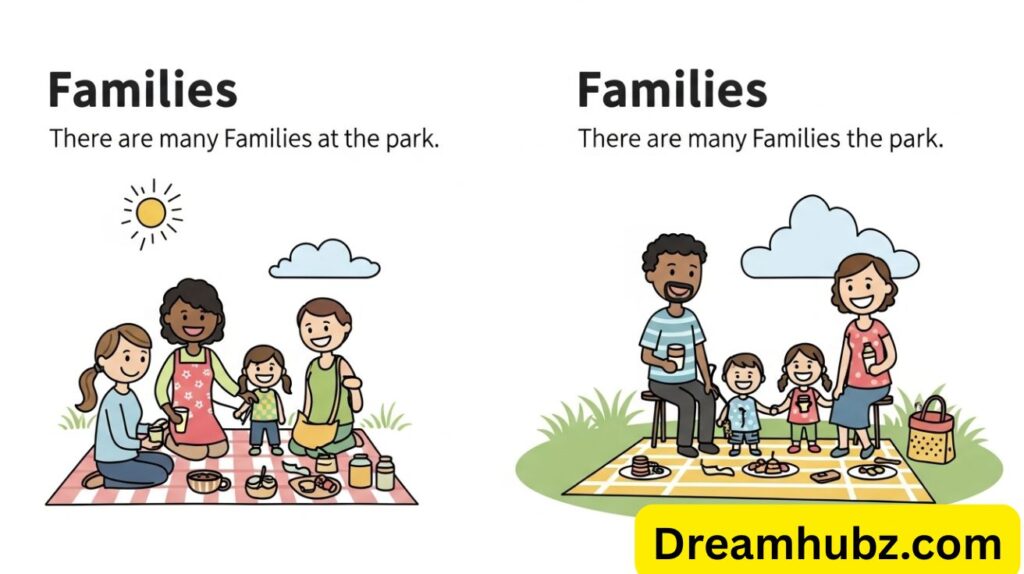Family’s or Families’ or Families?
Families or family’s can look almost the same, but they mean different things. Families is the plural form of family, meaning more than one. Family’s is the singular possessive, showing something belongs to one family. These small grammar rules make a big difference in writing.
It is easy to get confused with apostrophes. A small mark can completely change your meaning. Many people make this mistake in school, work, or even legal writing. That is why knowing the difference is very important.
You use families when talking about many families together. You use family’s when showing ownership by a single family. These rules are part of simple grammar. Learning them helps you write clearly and avoid mistakes
Why Understanding Family’s, Families’, and Families is Important

When we talk about family grammar rules, we are not only dealing with language but also with clear communication. Using the wrong form can cause confusion in writing, whether you are writing a holiday card, a business email, or a legal contract. For example, the sentence “The families picnic is tomorrow” may seem simple, but it leaves readers unsure whether the event is hosted by one family or multiple families.
Understanding the singular possessive family, the plural possessive families, and the simple plural families plural form examples helps you write with accuracy. If you misuse these forms, people may misinterpret your message. This is why knowing the family’s vs families vs families’ differences is more than grammar—it is a skill for clear communication grammar tips that saves time, prevents arguments, and makes your writing professional.
Avoiding Ambiguity in Communication
Ambiguity happens when words or sentences can be understood in more than one way. Apostrophes are small marks, but they play a big role in clarity. With apostrophe usage in English, the placement of a single mark changes ownership, plurality, or both.
Consider these examples. “The family’s home” means one family owns the home. “The families’ homes” means several families own homes. “The families met” simply means several families gathered, without ownership. These are simple families possessive examples and families plural form examples, but they show how misunderstanding can easily arise.
The apostrophe placement rules must be followed to avoid confusion. If you forget the apostrophe altogether, you create what looks like a spelling error, such as “familys.” In English, this is incorrect because the plural nouns ending in -y must change the “y” to “ies,” giving us “families.”
Real-World Consequences
The misuse of grammar does not only confuse; it can also cause financial and legal problems. Consider grammar for legal documents, where one wrong apostrophe can change the meaning of a clause. A sentence like “the families property” could mean something very different than “the family’s property” or “the families’ property.” In the first case, without an apostrophe, the sentence is unclear. In the second case, only one family owns the property. In the third case, multiple families share ownership.
A case study from a real estate contract in the United States shows how correct apostrophe in contracts matters. Two families bought land together, but the agreement stated “the families property.” One family argued this meant shared ownership, while the other believed it meant one family was primarily responsible. This dispute delayed construction and led to lawyer fees. The revised version, “the families’ property,” solved the issue by making the plural possessive families form explicit.
This example highlights how ownership vs plurality in grammar can make or break a legal agreement. How to use family’s correctly is not just an academic question—it is a practical skill.
Building Credibility and Professionalism
Using the wrong form of family’s vs families’ in professional communication can hurt your image. In the workplace, bosses, colleagues, and clients notice details. If your email says “We appreciate our families support” instead of “We appreciate our families’ support,” it looks careless.
Grammar mistakes may seem small, but they create an impression. Clear grammar shows you pay attention to detail, while common grammar errors with families and other words may signal that you are not careful. For American professionals, mastering these family grammar rules strengthens both credibility and trust.
Preserving Relationships
Even in personal contexts, apostrophe mistakes can create confusion. Imagine you write “Our families traditions are special” when you meant to talk about just your own household. The reader may think you are referring to many families instead of your own. This is why family traditions grammar examples can be so important in everyday writing.
When sending invitations, greetings, or notes, using the correct possessive nouns examples makes your message warm and clear instead of confusing or misleading.
Why It Matters
At the heart of this topic lies one principle: clarity. Whether in a casual message, a business email, or a legal document, family’s vs families vs families’ must be used correctly. Grammar ensures that meaning is not only correct but also respected. Misplacing an apostrophe may not seem serious, but it could cost money, time, or even trust.
Understanding Family’s, Families’, and Families
Let us now break down the three forms with clear definitions, families possessive examples, and simple ways to remember them.
1. Family’s (Singular Possessive)
The form family’s meaning is ownership by one family. This is the singular possessive family form. You create it by adding an apostrophe followed by the letter “s.”
When to Use Family’s
Use it when something belongs to one family. For example, “The family’s car is parked outside” or “Our family’s traditions are unique.”
Examples in Context
“The family’s dog barked all night.”
“Our family’s story begins in Texas.”
“She enjoyed visiting the family’s summer cabin.”
Pro Tip
Think of this form as “of the family.” The possessive of family becomes clear when you test it: “the family’s garden” equals “the garden of the family.”
2. Families (Plural Form)
The form families meaning is simply the plural of “family.” It does not show ownership but only refers to more than one family. The correct plural of family follows the rule for plural nouns ending in -y: replace “y” with “ies.”
When to Use Families
You use “families” when describing a group of households. For example, “Several families joined the event” or “During the holidays, families gather to celebrate.”
Examples in Context
“Many families attended the school play.”
“The event was open to all local families.”
“Families come together every year for the parade.”
Pro Tip
Do not confuse this form with possession. “Families” is never possessive; it only shows plurality.
3. Families’ (Plural Possessive)
The form families’ meaning is ownership by more than one family. This is the plural possessive families form. You create it by adding an apostrophe after the “s.”
When to Use Families’
Use it when describing something that belongs to multiple families. For example, “The families’ concerns were addressed” or “The families’ homes were decorated for the festival.”
Examples in Context
“The families’ gardens looked beautiful in spring.”
“Both families’ traditions were honored in the ceremony.”
“The committee heard the families’ requests.”
Pro Tip
Remember: apostrophe before “s” means singular possession (family’s), and apostrophe after “s” means plural possession (families’).
Key Differences Between Family’s, Families, and Families’

Here is a simple table that highlights the differences between the three forms. This chart can serve as a quick reference when you are unsure which form to use.
| Term | Type | Meaning | Example Sentence |
| Family’s | Singular possessive | Belongs to one family | The family’s dog barked loudly. |
| Families | Plural form | Refers to multiple families | Many families joined the event. |
| Families’ | Plural possessive | Belongs to multiple families | The families’ gardens were beautiful. |
This table makes it easy to see the difference between plural and possessive.
Common Scenarios: When to Use Each Form
The easiest way to understand family’s vs families vs families’ is by looking at real-life situations. Each situation shows how one small change in apostrophe placement can completely change the meaning of a sentence.
Scenario 1: Writing Holiday Cards
Example
Incorrect: Wishing you joy from our families home to yours.
Correct: Wishing you joy from our family’s home to yours.
Why?
The phrase is about one home belonging to one family, so the singular possessive family form is required. Using “families” without an apostrophe is a grammar mistake with apostrophes, and using “families’” would wrongly suggest that several families share the same home. This shows why you must know how to use family’s correctly in personal writing.
Scenario 2: Community Events
Example
Incorrect: The families picnic is on Saturday.
Correct: The families’ picnic is on Saturday.
Why?
The event belongs to many families, so the plural possessive families form is needed. Without the apostrophe, it looks incomplete. This highlights the importance of apostrophe placement rules when creating flyers, newsletters, or invitations for public events.
Scenario 3: Business Correspondence
Example
Incorrect: We are grateful for our families feedback.
Correct: We are grateful for our families’ feedback.
Why?
In a professional setting, your writing represents your credibility. Errors like this are seen as common grammar errors with families and weaken your message. Using the correct form shows attention to detail and avoids confusion about whether feedback came from one family or many.
Scenario 4: Classroom Announcements
Example
Incorrect: A meeting will be held for the families of students.
Correct: A meeting will be held for the families of students.
Why?
This sentence is not showing possession. It is simply saying that multiple households will be present. This is a clear families plural form example. Remember that with plural nouns ending in -y, you replace “y” with “ies.”
Scenario 5: Contracts or Legal Documents
Example
Incorrect: The responsibilities for the families property are listed below.
Correct: The responsibilities for the families’ property are listed below.
Why?
This is where grammar can have serious consequences. In grammar for legal documents, even one misplaced apostrophe can change ownership. The corrected version makes it clear that the property belongs to more than one family. This is a textbook example of correct apostrophe in contracts.
Scenario 6: Social Media Post
Example
Incorrect: Celebrating our families traditions this holiday season.
Correct: Celebrating our family’s traditions this holiday season.
Why?
This post refers to the traditions of one family, not multiple families. Choosing the right form avoids confusion online, where mistakes spread quickly. This is a classic family traditions grammar example.
Scenario 7: Invitations
Example
Incorrect: You are invited to the families dinner.
Correct: You are invited to the family’s dinner.
Why?
If one household is hosting, you use the singular possessive family. If multiple households are hosting, you would write “the families’ dinner.” These are excellent families possessive examples that show the ownership vs plurality in grammar distinction.
Scenario 8: School Reports
Example
Incorrect: The report explains several families issues.
Correct: The report explains several families’ issues.
Why?
This sentence is about issues belonging to several families. Using the plural possessive families form communicates that clearly. Without the apostrophe, it looks incomplete and misleading.
Key Tips for Accurate Usage
Understanding the possessive of family is about more than memorization. Always ask yourself whether you are showing possession or just plurality. If it is ownership by one household, use family’s. If it is simply more than one household, use families. If it is ownership by several households, use families’. These simple clear communication grammar tips can prevent mistakes.
Read Also : 50 Examples of Figures of Speech: Mastering the Art of Expression
Tips to Avoid Mistake
To avoid errors, remember these facts. First, always consider the apostrophe usage in English rule that apostrophe before “s” shows singular possession, while apostrophe after “s” shows plural possession. Second, keep in mind that the plural of family is “families,” not “familys,” because of the rule about plural nouns ending in -y. Third, be aware that grammar mistakes with apostrophes are very common, but proofreading can fix them. Finally, think about context. If your sentence is about ownership, choose the right possessive form. If not, use the plural form.
Practice Exercises
Fill in the blanks with the correct form of the word:
- The ______ car is parked outside.
- Several ______ attended the fundraiser.
- Both ______ gardens were decorated for spring.
Answers
- Family’s
- Families
- Families’
Real-Life Case Study: Miscommunication in Legal Contracts
The Situation
Two families purchased a vacation property together. The contract stated, “the families property shall be maintained equally.”
The Problem
This wording was unclear. One family argued it was families’ meaning (shared ownership), while the other thought it was family’s meaning (one household’s responsibility). This misunderstanding delayed the project.
The Resolution
The contract was rewritten to read: “the families’ property shall be maintained equally by both parties.” This clarified that the property belonged to both families.
Key Takeaways
This case shows how important apostrophe placement rules are in real life. A missing apostrophe cost money, time, and peace of mind. It also proves why the difference between plural and possessive is not just a classroom lesson but a professional necessity.
Why It Matters
Learning the difference between family’s vs families vs families’ is more than a grammar exercise. It is about accuracy in communication. From family traditions grammar examples to correct apostrophe in contracts, using the right form prevents confusion, protects professionalism, and even avoids legal disputes.
To summarize:
Family’s = singular possessive (one family’s ownership).
Families = plural form (more than one family).
Families’ = plural possessive (ownership by multiple families).
So the next time you wonder about familys or families or families, remember that grammar is not just about rules—it is about clarity, trust, and effective communication in every part of life.
Why Confusion Happens with Family’s, Families, and Families’

Many writers in the USA mix up family’s vs families vs families’ because they look so similar. The small apostrophe can change the entire meaning of a sentence. The family’s meaning is singular possessive, the families meaning is just plural, and the families’ meaning is plural possessive. These fine details matter for clarity.
The problem often comes from not remembering apostrophe placement rules. Many people assume adding an “s” is enough. But English has exceptions, especially with plural nouns ending in -y. A missing apostrophe can turn ownership into plurality, or plurality into ownership. That’s why knowing family apostrophe rules helps avoid grammar mistakes with apostrophes in both casual writing and grammar for legal documents.
How Apostrophes Change Ownership and Plurality
The possessive of family depends on where you place the apostrophe. If you write family’s, it means something belongs to one household. For example, “the family’s car” shows a single group owns the car. If you write families’, it means many households own it together, like “the families’ park.”
On the other hand, the word families without an apostrophe simply shows there is more than one family. For instance, “Many families attended the event” is just a families plural form example. The challenge is remembering when to use singular possessive family or plural possessive families. A small mark makes a big difference in showing ownership vs plurality in grammar.
Real-Life Importance of Family Grammar Rules
In everyday life, the difference between family’s vs families’ can affect meaning. A teacher writing “families meeting” might confuse parents. Should it be one family’s meeting or a meeting for many families? Following clear communication grammar tips prevents misunderstanding. Correct word choice reflects professionalism and respect for your readers.
In law, these rules are even more serious. A property agreement that leaves out an apostrophe could change who owns the land. That is why lawyers follow strict family grammar rules and double-check correct apostrophe in contracts. Real-world examples show how common grammar errors with families can create disputes. Clarity in writing protects relationships, legal rights, and credibility.
FAQ,s
What is the difference between family’s and families?
Family’s shows possession by one family, while families is the plural form meaning more than one family.
What is the plural form of family?
The plural form of family is families, created by replacing “y” with “ies.”
What’s the difference between family and family members?
Family means the group as a single unit, while family members refers to the individuals in that group.
What is the use of families?
Families is used to show multiple families without possession, for example, “Many families enjoyed the festival.”
Final Thoughts
Mastering the difference between family’s, families, and families’ is essential for writing correctly. The family apostrophe rules may seem small, but they carry weight in daily life. From possessive nouns examples to clear communication grammar tips, learning the right form helps you avoid mistakes, build trust, and write with confidence.







